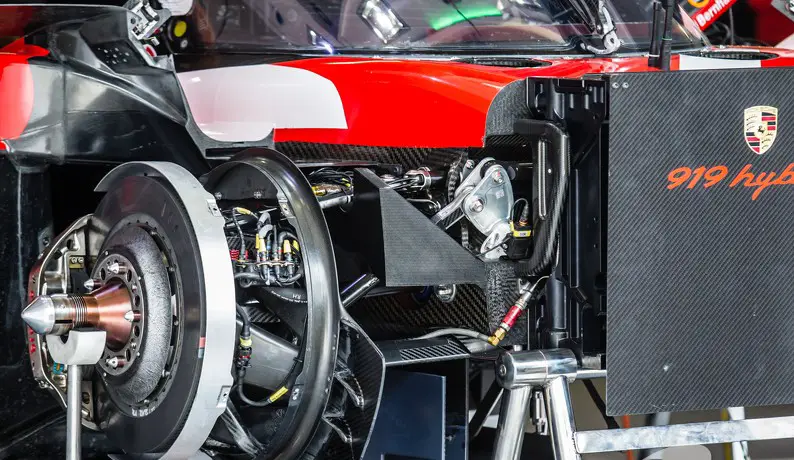F1 brakes are the unsung heroes in F1 cars. The reason that F1 cars can perform such amazingly quick lap times in circuits like Circuit Gilles Villeneuve in Montreal is due to the braking capability of the cars brakes.
While the engines and aerodynamics are the most talked about systems on an F1 car, the F1 brakes are critical. They provide a stopping force that is equivalent to 5G’s (five times the drivers weight), and the way they are set up and adjusted during a race can make the difference between winning or losing.
In this article we provide an easy-to-read review of F1 brakes and how they apply such a massive stopping force without the car skidding out of control.
How do F1 Brakes Stop the Cars So Fast?
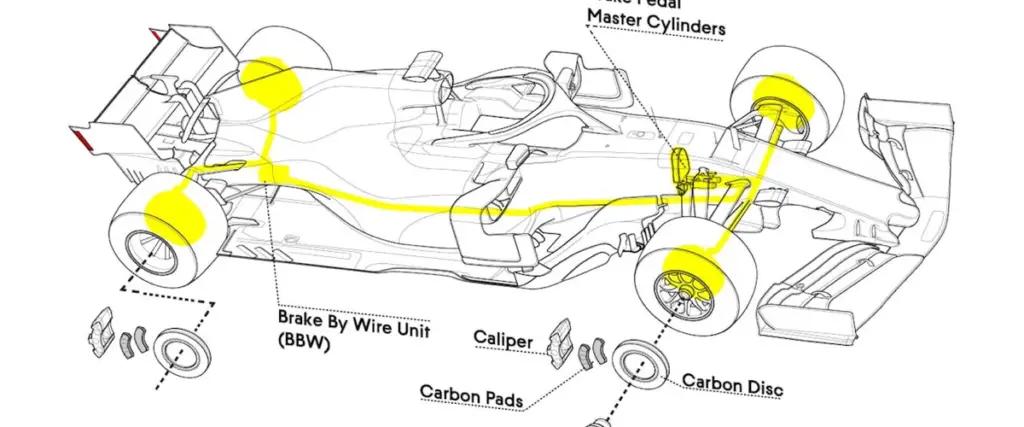
A normal road car will generally use a single hydraulically activated (power assisted) system. An F1 car has multiple braking systems.
F1 Brakes – The Aerodynamic System
The drag produced by an F1 car aerodynamics acts as a powerful braking system. If an F1 driver lifts his foot off the accelerator the aerodynamics (rear wing, front wing, and wheel structures) produce a 1G deceleration force.
That’s before the driver touches the brake pedal.
The downforce produced by the aero system has a secondary benefit. The aero system increase downforce and applies more pressure on the wheels.
It means the aerodynamic systems increase the pressure of the wheels on the track. The activated disc slows the wheel down. The additional downforce helps prevent the wheel from skidding.
The Hydraulic Disc F1 Brakes
F1 cars have a disc brake that is to mounted on each wheel. The following primary components make up the system.
F1 Brakes – A Disc on Each Wheel
A carbon fiber brake disc is installed on the inside of each wheel.
Carbon fiber is not chosen because of its heat resistant or endurance properties. Teams choose carbon fiber because it is such a light material.
F1 Brakes – The Calipers
Each caliper is made from aluminum beryllium and has six pistons inside which provide the pressure that “squashes” the brake pads against the disc.
F1 Brakes – The Regenerative Braking System
Since 2010 there have been energy recovery systems in F1 cars. When the F1 driver takes his foot off the accelerator and moves it onto the brake, the MGU-K (Motor Generator Unit – Kinetic) system kicks into gear.
The electric motor changes function and becomes an electrical generator that is used to recharge the battery.
The friction transmits through the system and rear axles and into the rear wheels, where it acts as a primary rear braking system.
F1 Brakes – Brake by Wire System
The difficulty with the MGU-K (Motor Generator Unit – Kinetic) system is that it only acts on the rear wheels and therefore affects the balance of the car.
Engineers install the Brake By Wire components into one of the car’s sidepods.
This ingenious system is attached to the brake lines between the front and rear brakes.
The unit measures the pressure the driver uses to press the brake pedal, and the brake bias set up. It works out how much braking force the driver needs.
The system then increases or reduces the hydraulic pressure on the rear wheels to ensure the cars balance remain within range.
F1 Brakes – Engine Braking
Just like in a road going car, the F1 driver can use the engine friction to reduce speed, either by taking his foot of the accelerator for a nominal braking force or by changing to a lower gear.
The Type of Corner Will Determine the Braking Needed
There are two fundamentally different braking actions needed in F1.
F1 Brakes – High Force Braking Acceleration
Circuits with a long high speed straight that ends with a sharp corner (turn 10 at the Circuit Gilles Villeneuve circuit.)
The cars speed down the straight at 285 km/h and the driver has to brake down to 60km/h to make the corner.
The drivers are pressing the throttle fully down, and then suddenly swop to the brake pedal where they exert up to 160kg/s of pressure. This pressure is twice the average weight of the driver.
On a corner of this nature the driver deploys all the braking systems.
- Aerodynamic system
- The Disc Brakes
- The Regenerative Braking System
- Brake By Wire System
- Engine Braking
The Aerodynamic braking is most effective at high speed, and as the car slows down it effect reduces quickly.
As the car slows down and the aerodynamics become less effective than the mechanical systems continue to provide stopping power.
When the driver steps on the brake pedal, it compresses two master brake cylinders – one for the front wheels and one for the rear – that generate fluid pressure.
The fluid pressure is delivered directly to the brake calipers. Inside each caliper, six pistons clamp pads against the disc
F1 Brakes – Smaller Braking Force Deceleration
The Parabolica at Monza is a great example where the drivers do not need full braking effort
In these categories of corners the driver will generally not use the brake pedal. Instead they lift off the accelerator but do not press the brake.
This allows the car to use the aero and the regenerative braking system to reduce speed. This reduces the wear on the tires and brake pads.
What are the F1 brake discs made from?
The choice of carbon fiber serves two primary purposes, dispelling the misconception that steel brakes are less potent. Firstly, carbon fiber is inherently lighter than steel, contributing to the overall weight efficiency of the car. Secondly, it excels at handling high temperatures, a crucial factor in the demanding conditions of F1 racing.
The use of carbon fiber in F1 brakes traces its roots back to its introduction in aircraft, later adapted to Formula 1 by Gordon Murray at Brabham in the early 1980s. While carbon discs offer undeniable advantages, the trade-off comes in the form of higher costs. Nevertheless, the weight reduction benefits make carbon disc brakes the default choice since overcoming initial challenges in the 1980s.
The Temperature must be Carefully Controlled
Maintaining the ideal working temperature proves to be a significant challenge for these brakes. If the temperature falls below 300 degrees Celsius, the brakes lose their bite, while exceeding 1000 degrees Celsius causes oxidation and increased wear.
Precise control of brake duct sizing helps retain heat, with overheating presenting a more significant concern. Prolonged exposure to extreme temperatures risks disc thinning due to oxidation, potentially resulting in catastrophic failure.
The evolution of brake cooling strategies has seen an increase in the number of radial cooling holes, initially similar to those in steel discs. As teams pushed the limits of brake materials, the need for more effective cooling became apparent. The count of cooling holes rose from 100 in 2005 to approximately 1500 in 2019, reaching a structural threshold were adding more would compromise the integrity of the brake system.
Why Do F1 Brakes Emit Smoke?
The smoke that some F1 brakes emit is the carbon dust from the brake discs. It forms a cloud, in and around the brake unit, when released.
Why Do Teams Not Fit Bigger F1 Brake Ducts To Cool Them Quicker
There are two reason why teams don’t simply fit bigger drakes ducts.
- The first reason is that bigger brake ducts will increase the drag on the car.
- There is a bigger risk that a contaminant will go down there and block the duct and prevent the F1 brakes from cooling altogether.
Why Do F1 Brakes Sometimes Catch Alight?
When the brakes emit extreme heat the brake dust may catch alight, mainly in the pit when the cooling air is not present.
The F1 engineers call the process that causes this heat soak. It describes the condition when the brakes continue to heat up even though the car is stopped.
This exists when the ambient temperature is heating up the local temperature.
Mechanics reverse this by installing cooling fans. Very infrequently the fire may spread which becomes a major problem!
Why Do F1 Brakes Lock Up?

F1 Aficionados use several terms to describe this condition.
- Tire Lock Up
- Under Rotation
- A Slip
- A Skid
- Tire Saturation
The force to stop the car is provided by the brake disc and the calipers. The actual stopping action is provided by the tire’s themselves.
F1 Brakes – Free Rolling Speed
The free rolling speed of the tire is the circumference of the tire (e.g. 1 meter). The car will move forward (1 meter) for every rotation of the tire.
For braking to happen the rotation of the tire needs to rotate more slowly relative to the forward motion. This reduction in rotational speed creates a velocity difference between the road and the tire – this action is called “Negative Slip.”
F1 Brakes – Negative Slip
The Negative Slip provides the tractive force that slows the wheel down. If the velocity difference falls outside of a performance window the negative slip becomes too high, and the wheel starts to under rotate.
F1 Brakes – Flat Spots
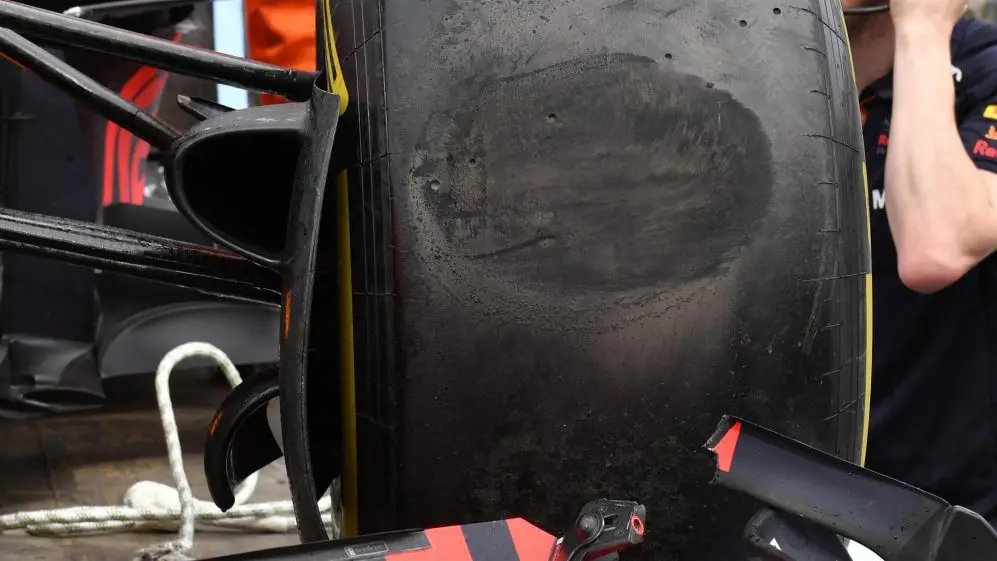
When the tire locks up it means that there is no more grip available. At this point the driver has essentially lost control of the car and the tire develops a flat spot.
Flat spots affect the handling because it unbalances the tire and changes its rotational shape. The effect is that the driver will experience vibrations through the steering wheel and teh car may be more difficult to control.
Do F1 Brakes Have ABS?
F1 cars are not fitted with ABS systems that lift the braking force when the tire begins skidding.
This means the driver has to practice “Cadence” braking where he releases the brake pressure in a series of pumping actions.
What Happens To The Forces On An F1 Car Under Braking?
When the driver activates the brakes at high speed the down force is very high. This means that maximum braking force is available without the tires locking up.
As the speed reduces the down force also lessens, and so it is easier for the tires to lock up. To manage this the driver changes the brake bias between the front and rear axles.
Terms used to describe the different forces on the rear and front brakes are.
- Brake Bias
- Brake Migration
- Brake Shake
Broadly these terms mean the same thing. They refer to the difference in braking force on the front axle compared to the rear.
When the driver 1st applies the brakes there is a higher stopping force in the front axle. Decreasing the brake force distribution adds a greater force to the rear.
Can F1 Cars Steer While Braking?
It depends on the degree of braking force being applied.
On some corners the drivers will brake hard, slow the car down sufficiently and then release the brakes and let the car roll around the corner.
In other corners the driver will keep using brake force into the corner. Engineers call this trail braking.
Do F1 Cars Have Handbrakes?
F1 cars do not have a lever that they pull to activate a “handbrake” on the car.
Some teams talk about the handbrake effect. What they mean is that the car has a braking setting where the brake pressure is increased to the back wheels.
This makes the rear tires slip (very slightly) into a corner. It causes a lateral movement and enables the driver to turn the car faster – this is a like a small drifting effect.
How Hot Do F1 Brakes Get?
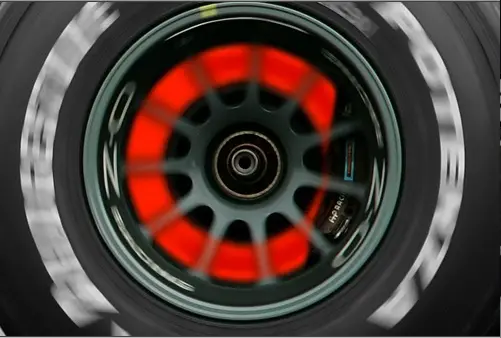
The brake temperatures operate above 400o degrees c. Pressing the brake pedal increases the temperature to 1000o c.
The brakes only work effectively between these two values. If the brakes are too cold or the temperatures exceed 1000oc the stopping performance deteriorates.
When the brakes are too cold, they tend to “grab” which makes the brake force uneven. A classic symptom is one (or more) of the wheels locking up.
If the brakes are too hot oxidation occurs which changes the composition of the brake discs. This degrades the brakes stopping ability .
Why Are F1 Brakes So Hard To Push?
Getting the braking right is a very precise skill.
In qualifying it is fairly straight forward, a maximum acceleration and braking force is required for the session.
In the main race the requirements are very different.
The F1 Brakes Must Last
The settings used in the qualifying sessions are not sustainable and will lead to excessive brake and tire wear.
The Braking Force Must Change Through A Race
When the race starts, each F1 car has full gas tanks which weigh 100kg’s. This represents more than 15% of the cars weight.
As the gas is used the drivers must change the brake settings to compensate for the reduced weight (and therefore reduced downforce.)
F1 Brakes and Tire Wear Must Be Considered
F1 drivers are required to use at least two different tire compounds during a race. Each tire compound has different grip and wear capabilities.
The brake force applied must take into account the type of tire and its wear characteristics. A hard tire may be able to sustain harder braking forces, and the opposite may be true for a soft tire.
What Forces Do Formula One Brakes Exert?
At most a normal road car will produce 1G of acceleration. This is very small compared to an F1 car which produces upwards of 5G’s. To explain the G forces
- 1G is like having another person on top of the driver.
- The 5G’s that an F1 driver experiences is the equivalent of having 5 F1 drivers sitting on him.
Why can you See F1 Brakes Glowing?
There are two main reasons why you can see F1 Brakes Glowing
Incandescence and Thermal Radiation
The intense heat generated during braking causes the brake discs to reach temperatures that induce incandescence. Incandescence is the emission of light by a body due to its high temperature. In simpler terms, the brakes become so hot that they start to glow. This phenomenon is a result of thermal radiation, where the extreme heat causes the material to emit visible light.
Colors and Temperatures
The colors of the glowing brakes provide insights into their temperatures. Initially, the brakes appear red, progressing through shades of orange and yellow as the temperature increases. The varying colors indicate different temperature ranges, with white being the hottest. Engineers closely monitor these colors to gauge the brakes’ performance and ensure they operate within the optimal temperature range.
How Do F1 Drivers Know When To Brake?
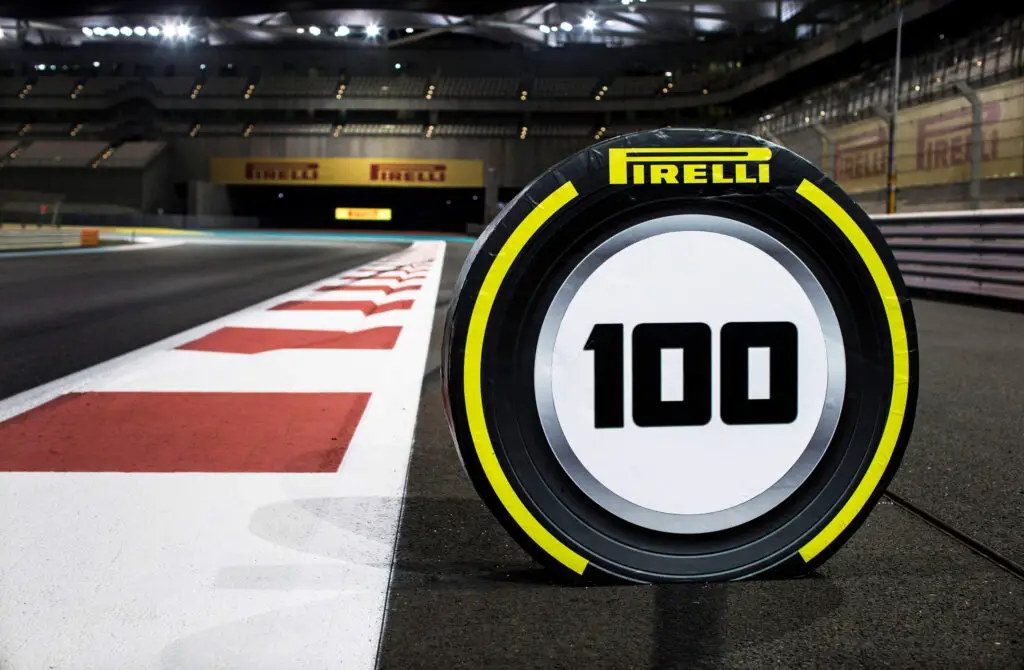
The difference between drivers who qualify at the front of the grid and those at the back is measured in 1000th of a second. Part of this difference is the drivers knowing when to brake and how hard to brake. Getting it right is one of the differences between great F1 drivers and the rest of the pack.
But how do F1 drivers know when to brake?
The circuit designers in a braking marker before each corner. It shows the distance to the corner and the driver uses this to work out the optimal point at which he should start braking. If the driver is trying to out brake a competitor, he may leave the braking action by a tiny margin in the hope that the other guy is braking harder and thus slowing down faster.
Should he be successful, he will arrive at the corner slightly in front of the other car which means he has the choice of line into the corner.
If he gets it wrong he will enter the corner too fast and either skid into the run off area (or crash) or will have to take a “non-optimal” racing line through corner, which will enable the other driver to stay in front
How Much Do F1 Brakes Cost?
A set of brakes for an F1 car cost approximately $200,000.
The high cost of F1 brakes is caused by the following factors
- The materials used in their manufacture
- The process involved in the F1 brakes manufacture costs more because it is not scaled and so the individual unit are not scaled over a large manufacturing run
Formula 1 Brakes – Conclusion
Brakes are just as important as any other part of an F1 car. The mechanics must set the brakes the correctly, that they have the endurance to get through a race and that the driver is able to manage the settings during the race to ensure they stay at maximum effectiveness.
And some people thought that being an F1 driver is easy!
Our Library Of Articles
If you found this article interesting, there are other similar posts on f1worldwide.com
You can find other interesting articles below.

